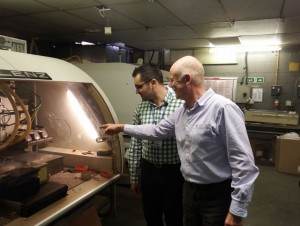
Newbury Electronics’ Involvement in Making Star Trek Medical Tricorder a Reality
Newbury Electronics has been appointed as the manufacturing partner in helping to develop a handheld testing device which will provide same day diagnosis from a patient’s bedside. Newbury Electronics is delighted to work with the University of Southampton and help transform this idea into a feasible product. Below Managing Director, Philip King, has answered a few questions on Newbury Electronics’ involvement in this exciting new research.
How did Newbury Electronics gain this contract?
We have had a longstanding supplier relationship with both University College London and Southampton University and their associated start-up companies delivering both printed circuit boards and electronic assembly services across many projects. Newbury Electronics Ltd is an owner managed business, and we are able to make quick decisions. The level of commitment needed to support research projects as a commercial partner is not easily quantifiable at the outset, so a willing partner needs to be far sighted, flexible, and tolerant of risk. When we were approached to take part in the project, we were prepared to support the submission.
How much input did Newbury Electronics have in this project?
The researchers at Southampton University lead the project. They have a huge knowledgebase of the biochemical, clinical and electronic processing techniques plus the laboratory back-up that are required to make this technology work. Newbury Electronics role will be to guide the team in using established and proven manufacturing techniques directed to fabricate innovative products. The boundaries of what can be done with existing manufacturing processes may be pushed to the limit, and that is the point, we will see how far down this road we can go. New techniques such as direct imaging for example, are being introduced into PCB manufacturing and these may open up new possibilities to explore.
What benefits have Newbury Electronics brought to this project?
We have decades of experience making hundreds of thousands of different circuit board designs. We have tried many innovations to enhance our manufacturing process, some have worked, and some have not. But every year, our process incrementally improved. We bring practical experience of dealing with cost control, quality of product and the stability of processes. This knowledge is not documented in the public domain. It cannot be “googled”. We have experience of the limitation of production techniques and we can help match product design with actual manufacturing capability.
Why do this with a PCB and not on silicon?
Making the PCB an active element in the chemical analysis of fluid samples seems to have been overlooked in favour of micro-fluidics development using silicon chips. Chip development is hugely expensive whilst the PCB is the Cinderella at the party. Of course the physical scale is much larger, but relative to the current analytical techniques, a PCB based process would be a huge advance.
How long was the process to make the PCB? How many boards have been made/are required for the device?
The initial development of the PCBs we have manufactured for Southampton University were only modest developments of existing PCB technology, but they proved certain important aspects of the project. Again, the point of our collaboration is to enhance the chances that a practical device can be manufactured, and the best chance will be achieved if the manufacturing methods are proven and understood, even if they are applied in new ways.
If this device is a success, what could this mean for Newbury Electronics if the device is used worldwide?
The potential could be enormous. I think NEL would remain true to its origins and continue with development of further products based on this and other concepts. We would certainly be keen to be involved in spin-off businesses to exploit these particular ideas. It is hard to predict where the research will take this project, but we are eager to grasp opportunities as they present and see where they run.

